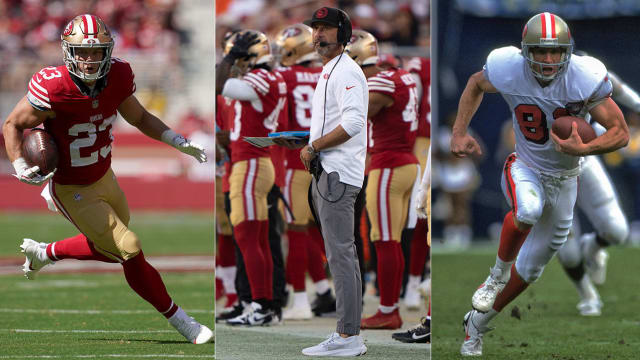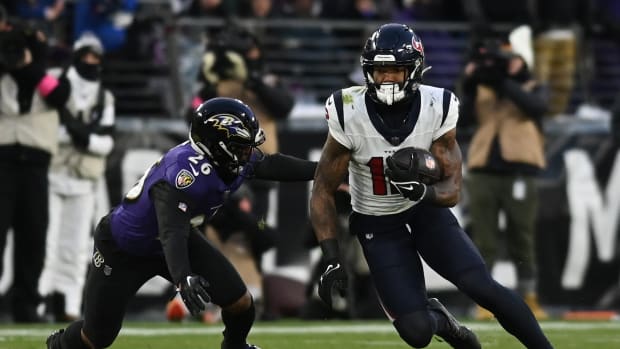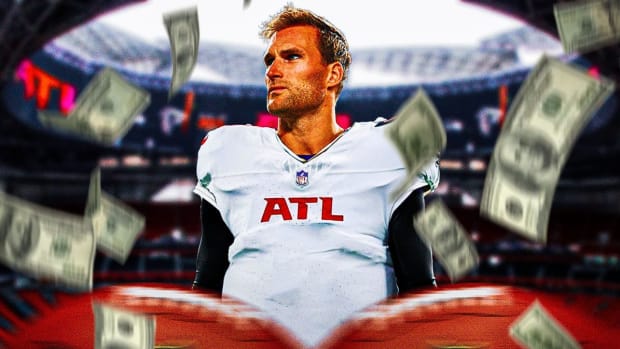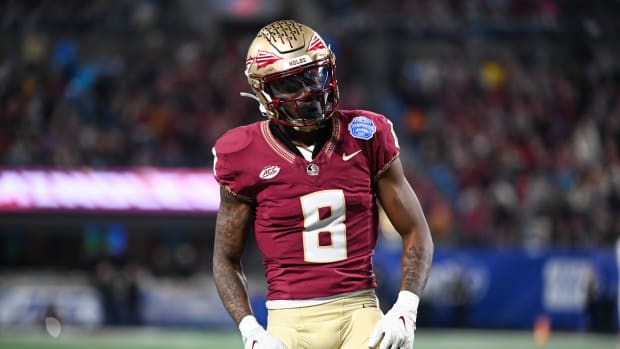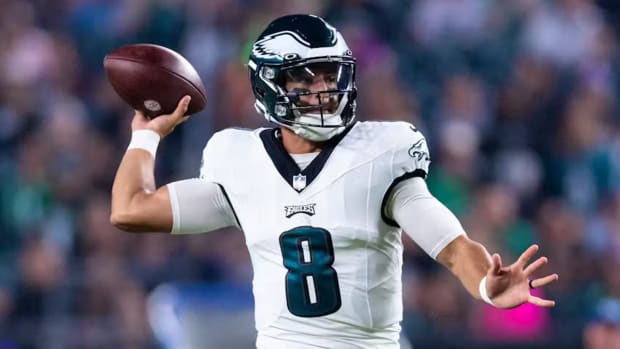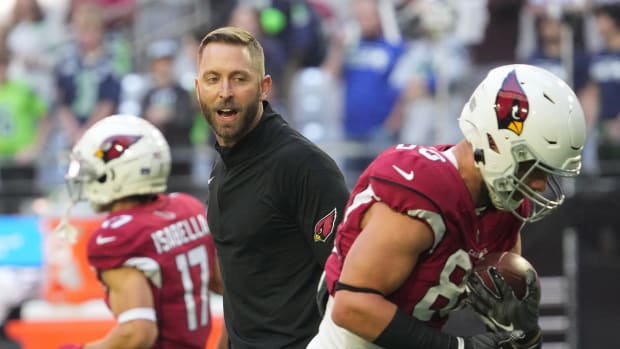Kyle Shanahan’s 49ers Once Again Fall Short of Super Bowl Title
The teenager tagged along to practice, became a ball boy and said yes to any dinner, ice cream or equipment those famous NFL players offered. This marked Kyle Shanahan’s introduction to his future.
This life, glorious as it was, didn’t exist solely in the realm of rainbows, passing yards and Lombardi Trophies. Kyle grew up a coach’s son, watching his father, Mike, lose Super Bowls, get fired and, finally, in 1992, land in football nirvana with the San Francisco 49ers, winner of four championships in the previous 11 seasons.
[Buy now! Relive Super Bowl LVIII with Sports Illustrated’s commemorative issue]
The Niners returned to the game that was their birthright after the 1994 season. That Christmas, Kyle unwrapped a Deion Sanders jersey. He wore the white No. 21 that day and every day after until Super Bowl XXIX on Jan. 29. His father recalls Kyle only removing his new uniform to shower and, sometimes, to sleep—for 35 days. Mike tried to talk Kyle out of his superstition: “You’re going to get a bad rap,” he said. “You’re going to stink if you keep wearing that thing.” (Kyle insists he changed undershirts daily, mitigating any stench.) But what matters is they won that day, the Shanahans, father and son.
What matters now, in 2024, is how that season pointed Kyle toward his calling—how after the Big Game he began diagramming plays at the breakfast table, breaking down every route run by 49ers wideouts Jerry Rice and John Taylor.
And yet that calling remains, with one thing missing from Kyle’s résumé after his 49ers lost Super Bowl LVIII, 25–22, to the Kansas City Chiefs in Las Vegas.
Mike left for Denver the next season. Kyle packed the Deion jersey, after turning down an offer for $200. Mike asked for permission to take only one player: Ed McCaffrey. And, three seasons later, all were in the Super Bowl. Kyle and his friends stayed in Mike’s room, where, on the morning of the game, Kyle asked what his dad thought of the game-plan spread before them. “We’re going to kick their ass,” Mike told them.
Consider Kyle Shanahan an architect primarily, a design wizard and builder extraordinaire, forever innovative and creative. Kyle never stopped pursuing the NFL head coaching job he wanted. Not at UCLA. Not with the Buccaneers. Not in Houston, Washington, Cleveland or Atlanta, stops he made on his path to changing offensive football more than once.
Heavy sentiments hung over him throughout. Like the departures in Washington and Cleveland. Like his father’s reputation. Like 28–3, the mid–Super Bowl LI score that's now immortalized for what happened later that night. The next part still hangs over Kyle, the offensive coordinator at the time. Too conservative at times, not conservative enough at others (and all clear only in hindsight), Atlanta’s collapse against New England dropped largely atop his head. For years, Dan Quinn, then the Falcons coach and now the Commanders boss, tried to absolve Kyle of blame.
Kyle had balanced Patriots prep with job interviews. Of the four he landed, the one with San Francisco appealed to him the least. From a roster talent standpoint, the Niners “made me nervous,” Shanahan told Sports Illustrated in 2020. “I didn’t want to take a job and get fired right away.” Part of what convinced him were the six-year contracts given to him and new general manager John Lynch. The length meant stability; stability meant time to shape.
At least that’s how they drew it up.
The next six years in San Francisco went like this: losing season, losing season, Super Bowl defeat, losing season, conference championship defeat, conference championship defeat. Between the Falcons collapse and three losses in his three biggest games as a head coach, another tag became affixed to Kyle. It wasn’t fair, but it stuck anyway: He couldn’t win the big ones.
All the quarterback shuffling didn’t help. Injuries didn’t, either. But facts didn’t matter to the microwave-reaction types. Let’s take a look:
The record of one 49ers coach after his first five seasons: 34–39, two conference championship appearances, one Super Bowl reached.
The record of another 49ers coach after his first five seasons: 39–42, two conference championship appearances, one Super Bowl reached.
The second: Kyle Shanahan.
The first: Bill Walsh.
The difference: Kyle, as a renowned architect, had still yet to shape his masterpiece.
After Sunday’s bitter-no-sweet defeat, he left the field at Allegiant Stadium with an expression that fell somewhere between shocked and gobsmacked. Another Super Bowl. Another loss. He remains the architect. And he remains the architect who has not yet shaped his masterpiece.
For John Bosa, Feb. 2, 2020 sometimes feels like a nightmare from another life. It was San Francisco’s first Super Bowl loss to Kansas City, before spates of injury-related misfortune, round after round of quarterback duck-duck-goose and three more title-less seasons.
In 2020, John saw television clips from NBC of his son, Nick, the Niners rookie defensive force. The camera zoomed in tight on Nick’s face, catching him on a bench, pinching his nose, pushing his forehead and … bawling. “That was a really scary moment,” John says.
The scary part was what John knew from his own NFL experience, from those three late-1980s seasons in Miami. Few humans in history could throw a better spiral than Dan Marino, who remained the Dolphins starting quarterback at the time. But, while Marino didn’t know it yet, he had already peaked. He told John Bosa how much his lone Super Bowl defeat—to San Francisco, of all teams—already haunted him.
On that night four years ago, John Bosa knew they must bring it into the open. So Nick could deal with the pain from a loss that felt more existential, in order to one day return. John knew he needed to tell this exact story to his son. He knew even hearing it would sting.
“Nick,” his father told him that night,” there’s no guarantee you’ll make it back.”
But He did. And not just back, but there, right there, ahead near the end of regulation, ahead in overtime, so-so-so close. Nick spent half of Sunday in the Kansas City backfield. The Niners defense bottled up Chiefs QB Patrick Mahomes. Brock Purdy made elite throws, as did Jauan Jennings, who threw a TD himself. Christian McCaffrey scored again—on that throw from Jennings. Rookie kicker Jake Moody didn’t miss. But the Chiefs blocked an extra point attempt. They slowed Shanahan’s offense. They scored just enough points.
San Francisco landed in the most familiar—and most agonizing—position. Again. Close but not enough. Elite but not champions. Team Almost, with another loss in the biggest game in American sports.
This is the story of their latest heartbreak, latest change-one-play-here-or-there-and-they’re-viewed-like-Kansas City. This is their latest almost. Right now, it hurts more than the others.
The comeback started amid despair, the same day as the injury. The wait was easily the worst part. It lasted 40 days. The worst part of that worst part: Purdy wouldn’t find out which surgery he needed until surgeons cut into his arm. Two available options meant two vastly different recovery timetables. On March 10, the incision cut in a positive direction. Purdy needed an InternalBrace augmentation, a procedure that doesn’t require a tendon graft for ligament reconstruction and requires a recovery time of five to seven months. The other method, commonly known as Tommy John surgery, requires a tendon graft, which would have meant missing games.
Rehabilitation started in Arizona, Purdy’s home state. His physical therapist was based there, not far from the MLB spring training sites his surgeon would also visit. Purdy started with the easier stuff, like range-of-motion exercises. He checked in with the 49ers to shape an initial plan. He flew to Florida to work with his orthopedic specialist/trainer, Tom Gormely, and his private coach, Will Hewlett. The next steps in Purdy’s “progression of arm care,” says Gormely, were plyometric exercises, throwing development (adding more types of throws, plus more reps of all types) and strengthening his arm.
That first afternoon in Jacksonville, Purdy strolled back onto a football field with his other team. He looked, to the surprise of everyone, pretty damn good. “Like old Brock,” Gormely says, meaning Purdy before their draft prep, the difference coming from muscle memory that reintroduced habits he had already fixed during the resting period of recovery. No pain that night in his surgically repaired elbow. No pain the next morning.
After his second week in Jacksonville, Purdy was already handling what Gormely considered a “normal load” of work. Not the same number of throws yet, but all the different types required. His max distance, velocity and spin rates all trended upward. After three weeks, Purdy could step into throws with the same force as before the tear. This guy, Gormely thought to himself, not wanting to voice the striking progress, has a real chance.
So did San Francisco. With Purdy on the mend … McCaffrey fully acclimated after half-a-season in town … a new, promising kicker in third-round draftee Jake Moody … an advantage strengthened by adding defensive tackle Javon Hargrave in free agency … and a healthy Deebo Samuel, the single player the Niners win most with and lose far more without… . Oddsmakers made the 49ers a preseason contender to do what they hadn’t done since 1995: win the whole damn thing.
One complication happened immediately. It always seems to, in San Francisco. Nick Bosa held out of camp and early-season practices for 43 days. No one blamed him for capitalizing on his reigning DPOY leverage to sign a five-year extension worth up to $170 million. But several pointed out that he didn’t record his first sack until Week 3, and didn’t take over any game until the Niners smacked Jacksonville around after their bye week.
“Nick has admitted to me that he could tell the difference between how he felt those first few games [after] not [practicing],” his father says. “He didn’t think it would affect him that much. But it did.”
McCaffrey powered the 49ers’ first half almost single-handedly as he settled in with the franchise his father, wideout Ed McCaffrey, had helped win that last Super Bowl nearly 30 years earlier. Run CMC, as he’s called, played 23 snaps in his first game in a new uniform after being acquired (stolen) last season from the Panthers, against the Chiefs. McCaffrey scored three times in the next two games. But he didn’t squeeze, trot or flip into the end zone once for two whole weeks after that, notable only because he scored at least one TD in all six remaining regular-season contests, all playoff games and the first eight contests this season. That marked 17 straight with at least one end zone celebration, elevating McCaffrey above the NFL’s longest scoring streaks, including Jerry Rice, O.J. Simpson, John Riggins and Emmitt Smith. (His father loved hearing all the stories, but nothing surpassed seeing “Christian McCaffrey” and “Jerry Rice,” the former teammate who taught Ed how to win, in the same sentence.)
As the Niners started 5–0, McCaffrey scored eight times. (Mike Shanahan says his son was enamored with McCaffrey before the draft in 2017, that Kyle wanted him more than any other projected top 10 player. But the Niners weren't going to take a running back that high.) Four of those came in a single week against the Cardinals. The 49ers outscored their opponents by 99 points in that stretch. Two close losses to the Browns and Vikings followed, as did another defeat from the Bengals. McCaffrey still notched five scores in that stretch.
Funnily enough, McCaffrey didn’t score in the get-right victory over Jacksonville following an ideally timed bye. He drew so much attention he didn’t need another touchdown, exchanging the streak for the Niners to find their soul again. Then: five more wins.
McCaffrey (Ravens holiday battering notwithstanding) just … kept … scoring. Including the playoffs, he recorded seven games with multiple touchdowns, including four where he scored at least two ways. He had fewer weeks where he didn’t score than weeks where he scored at least twice. Only three defenses kept him out of the end zone, and only one, the Commanders, bottled him.
“He was brought in to be a force multiplier,” Ed says.
Between the regular season and the playoffs, McCaffrey scored 26 times. No 49er, not even Rice, did that. Consider the force multiplied.
Dots began connecting for the team already powered by connections. For example, most fans assume their favorite GMs only look to bolster positions of need near the trade deadline. Not true. Sometimes the best adds come from bolstering strengths.
Which explains the headline that shook NFL front offices on Nov. 1. It was official, the move the Niners made, and spookier than any costume seen the night before. For the bargain price of a third-round compensatory pick in next spring’s draft, Lynch snagged Chase Young from the Commanders. Young was far more than a former No. 2 pick who played for a franchise that seemed to aspire to mediocrity. Like Bosa, his college teammate at Ohio State, Young won Defensive Rookie of the Year (2020). Like Nick, he made a Pro Bowl roster (’21).
John Bosa, who spent three years as a defensive lineman with the Dolphins in the 1980s, saw the trade for Young as further proof of an already obvious trend. This is the golden age of D-line play, and one special player isn’t enough. Not when those units win Super Bowls.
Speaking of, another moment: Philadelphia, revenge, Week 13. Purdy threw for more than 300 yards. Samuel scored three times. McCaffrey, naturally, added another touchdown. As far as omens go, this one, the Niners’ fourth-straight victory by at least 13 points, projected a complete team rounding into ideal late-season form.
Still, the 49ers exhibited a remarkable—and, sometimes, concerning—duality all season. Their point differential, a staggering +193, highlighted their more-often-than-not dominance. But they also finished 12–5, below their expected win total, based on that differential, of 13.
Anyone with a social media account understood: That was Purdy’s fault. Which wasn’t true but took hold anyway.
Of all the most common Purdy misconceptions, the one that bothers those who know him most centers on a lack of athleticism. None of them are saying Purdy will one day win gold in the Olympic decathlon. But he is an athlete, and just because he looks like he should work in a cubicle, that baseline isn’t going to change.
One simple counter: At the combine, he covered 10 yards of his 40 in 1.55 seconds, posting the same time as McCaffrey himself. That’s fast-fast, and also central to his skill set. Purdy’s initial bursts allow him to evade pass rushers, sprint downfield and, most importantly, throw darts while on the run. None of these qualities qualify Purdy as a “game manager” in the classic disparaging sense. If anything, they speak to the opposite.
Anthony Richardson, who’s generally and fairly regarded as one of the top athletes on the planet who also happens to play quarterback, is currently rehabbing an injury with Gormely. The Colts quarterback, says Gormely, is impressed by Purdy’s athleticism. “I don’t understand this narrative,” Richardson told him. “Aren’t we supposed to be system QBs? Aren’t I supposed to play inside of my system?”
Purdy never made excuses. Never thumped his chest. Never responded to anyone about anything. “I didn’t even hear it [once],” Gormely says. “Not only is he not game-managing, he’s making plays. He’s doing it 365 days away from a complete rupture of his UCL, which is insane.”
Perhaps this unnecessary, illogical debate centers on two men: a genius coach and his latest protégé, the latter exuding Rudy vibes en route to MVP contention. (In fact, Angelo Pizzo, the legendary screenwriter who penned the script in question, told SI that Purdy “is not Rudy.”)
What if both instead offered exactly what the other needed?
The Niners didn’t exactly march through the playoffs. They survived the Packers then roared back against the Lions. The latter win, per longtime Bay Area sports columnist Tim Kawakami, “justified an era.” The one where the ball boy brought the 49ers all the way back.
“Man,” Rice says six days before the Super Bowl, “what a story.”
Rice can’t believe almost three decades have gone by since the last triumph. He can’t believe they lost to Baltimore in XLVII, and how little they ran the football against the Chiefs in LIV.
He loves Purdy. He sees signs: For every Super Bowl Rice ever played in, nerves swirled, heightening, until he couldn’t eat or sleep. “Almost like the Kentucky Derby, where these horses know something big is about to happen,” he says. This week, he felt them. Butterflies taking flight.
Rice doesn’t remember the ball boy from 1994. Ed does. He recalls teenage Kyle always smiling, catching passes from Steve Young, helping Rice with releases off the line. It was clear. Kyle wanted in. Wanting is one thing. Being is another. Football, as John Bosa told his son, doesn’t work on wishes.
The best teams can do no more than give themselves a chance, in more years than not. What Rice calls Kyle’s “opportunity for redemption” isn’t about 28–3. It’s about joining his father and matching Niners titles. It took Andy Reid nearly 21 seasons to bathe in a confetti shower for the first time as a head coach. He was 61. Kyle is 44. He has a lot of time left.
His record says what he never will. There are missteps, yes, but there is also brilliance, all over, from the quarterbacks he coaxed to record seasons to the offenses he steered toward staggering statistics.
One win doesn’t change that.
One win does.
Much like his father almost 30 years ago, Kyle took his initial shots at Super Bowls in San Francisco. This time, he wore wide-brimmed hats rather than Prime Time throwbacks. He is the head coach, while Mike was an assistant. But the circumstances aren’t all that different. There’s still a Shanahan with scars and a franchise that was soaring, coming to a crashing halt on the biggest stage yet. The Shanahans could have been the first father-son combo in NFL history to lead teams to Super Bowl triumphs. Alas, another almost interrupted that history. Again.



































